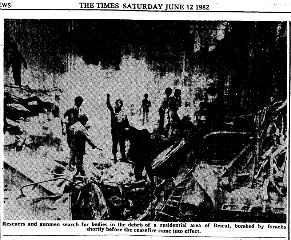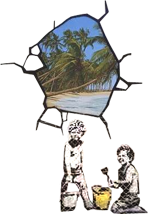
The Siege of Beirut and the Ethics of Representation Symposium
A joint event organised by Dr Caroline Rooney, ESRC Fellow and Chair, Centre for Colonial and Postcolonial Research, University of Kent and Dr Ayman El-Desouky, Chair, Centre for Cultural, Literary and Postcolonial Studies, SOAS.
Symposium Rationale
The sky of Beirut is a huge dome made of dark sheet metal. All-encompassing noon spreads its leisure in the bones. The horizon is like a slate of clear gray, nothing colouring it save the playful jets. A Hiroshima sky. I can, if I want, take chalk in hand and write whatever I want on the slate. A whim takes hold of me. What would I write if I were to go up to the roof of a tall building. ‘They shall not pass?’ It’s already been said. ‘May we face death, but long live the homeland?’ That’s been said before. ‘Hiroshima?’ That too has been said. The letters have all slipped out of my memory and fingers. I’ve forgotten the alphabet. All I remember are these six letters: B-E-I-R-U-T..jpg)
The Siege Of Beirut And The Ethics Of Representation
In 2004, Osama bin Laden claimed that the 9/11 attacks on the World Trade Centre were motivated by the Siege of Beirut in 1982, maintaining: ‘I couldn’t forget those moving scenes, blood and severed limbs, women and children sprawled everywhere.’ Robert Fisk points out that bin Laden was not in Beirut at the time of the Siege and therefore was probably responding to video footage he had seen and possibly to the eyewitness accounts of others. Fisk also recalls how the question of why the attacks of 9/11 occurred was avoided in their immediate aftermath, commenting: ‘If a crime is committed in Los Angeles or London, the first thing the cops do is look for a motive. But when an international crime against humanity in the United States was committed on this unprecedented scale, the one thing we were not allowed to do was seek a motive.’ He goes on to align the impact of 9/11 with the long shadow cast over it by the events of 16 September, 1982, as follows:
Nineteen years earlier, the greatest act of terrorism—using Israel’s own definition of that much misused word—in modern Middle Eastern history began. Typically, on 16 September 2001, no one remembered the anniversary in the West. I took a risk and wrote in the Independent that no other British newspaper –certainly no American newspaper—would recall the fact that on that date in 1982, Israel’s Phalangist militia allies started their three-day orgy of rape and knifing and murder in the Palestinian refugee camps of Sabra and Chatila. It followed an Israeli invasion of Lebanon—designed to drive the PLO out of the country and given the green light by the then US secretary of state, Alexander Haig—which cost the lives of 17,500 Lebanese and Palestinians, almost all of them civilians. That was more than five times the death toll in the September 11th, 2001, attacks. Yet I could not remember any vigils or memorial services or candle-lighting in America or the West for the innocent dead of Lebanon—no stirring speeches about democracy or liberty or ‘evil’.

The Siege of Beirut did, however, occasion a highly significant literary outpouring from a nationally diverse set of writers, including: Jean Genet, Prisoner of Love; Elias Khoury, The Journey of Little Gandhi; Jean Said Makdisi, Beirut Fragments; James Buchan, A Parish of Rich Women; Rawi Hage, De Niro’s Game; Rabih Alameddine, Koolaids: The Art of War and Mahmoud Darwish, Memory for Forgetfulness. More recently, the collective amnesia surrounding the Siege in an Israeli context, particularly with respect to the Sabra and Chatila massacre, has been the subject of a widely screened animated documentary, Waltz with Bashir, directed by Ari Folman, and Samuel Moaz’s Lebanon (set in 1982) has just won the Golden Lion at Venice. Even if slowly and belatedly, an international awareness of the traumatic events of 1982 in Lebanon, has come to a wider international public consciousness.
This symposium seeks to consider the literary representations of the siege alongside representations of the siege in journalism, and possibly also art and film. The project aims at investigating and promoting an awareness of an ethics of representation on questions of extreme emotional investment through comparing responsible reportage of traumatic events with literary renditions of those events. The following questions will be central to the area of enquiry: How can literature, journalism and art contribute to overcoming the dangers of forgetting and denial, memorial excess and fundamentalism, the radicalisation of violence and the complete breakdown of trust at international levels? How can they promote acknowledgment and mourning across divided communities? How can representation of the siege be compared to representations of 9/11 and other traumatic events? What are the challenges entailed in the witnessing of traumatic events? What is the role of language and visual and verbal metaphors in these representations?
